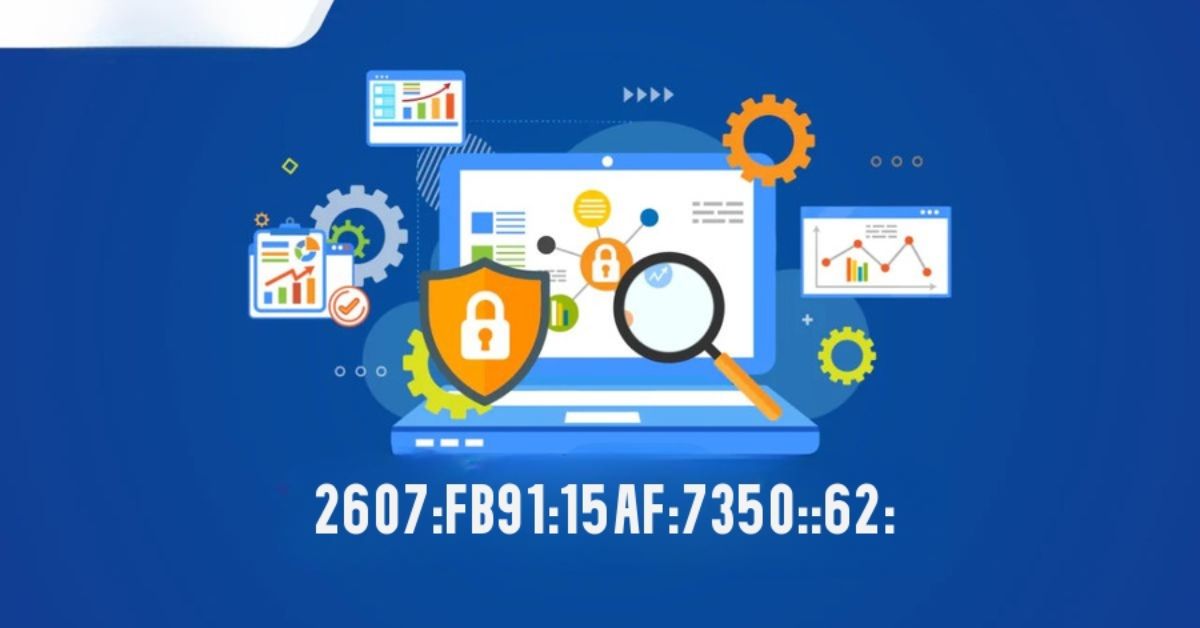In the vast digital realm, a unique identifyr lurks behind every online interaction: the IP address. These cryptic strings of numbers and letters serve as the backbone of internet communication, enabling devices to connect and exchange data seamlessly.
Enter 2607:fb91:15af:7350::62, an enigmatic IPv6 address that holds secrets of the modern internet. This seemingly random sequence represents a leap forward in addressing technology, designed to accommodate the exponential growth of connected devices.
As we delve into the depths of this IPv6 address, we’ll uncover its structure, significance, and the role it plays in shaping our interconnected world.
Also read this blog: https://bagispack.com/construction-erp-software-news-ticbus-com/
Introduction to IP Addresses
IP addresses are the digital fingerprints of devices connected to the internet. They act as unique identifiers, allowing data to be sent and received across networks. Without IP addresses, the internet as we know it wouldn’t function.
These numerical labels enable routers to direct traffic to the right destinations. As the internet grew, the need for a more robust addressing system became clear. This led to the development of IPv6, a new standard designed to meet the demands of our increasingly connected world.
What Are IP Addresses?
IP addresses are numerical labels assigned to devices on a network. They serve as identifiers for communication between devices. IP addresses come in two versions: IPv4 and IPv6, with the latter being more advanced and expansive.
Importance of Unique Identification
Unique identifiers ensure data reaches its intended destination. They allow devices to be recognized on networks. Without unique IP addresses, internet communication would be chaotic and unreliable.
Understanding IPv6
IPv6 was developed to address the limitations of IPv4. With billions of devices now connected to the internet, IPv4’s 4.3 billion unique addresses were no longer sufficient. IPv6 offers a vastly larger address space, ensuring we won’t run out anytime soon.
This new protocol also brings improvements in security, efficiency, and functionality. IPv6 addresses are longer and more complex than their IPv4 counterparts, using hexadecimal notation to represent a much larger range of possible addresses.
The Need for IPv6
IPv6 was created to solve address exhaustion. It provides a much larger pool of unique addresses. IPv6 also improves routing efficiency and network autoconfiguration.
Key Features of IPv6 Addresses
IPv6 uses 128-bit addresses, allowing for 340 undecillion unique addresses. It eliminates the need for NAT, improving end-to-end connectivity. IPv6 also enhances security and simplifies network management.
Also read this blog:https://bagispack.com/defstartup-console-tech-the-new-gaming-system/
Breaking Down the IPv6 Address: 2607:fb91:15af:7350::62
The IPv6 address 2607:fb91:15af:7350::62 represents a unique identifier in the vast landscape of internet protocols. This string of characters, seemingly random at first glance, actually follows a structured format that conveys important information about network hierarchy and device identification.
By dissecting this address, we can uncover insights into its allocation, network structure, and even geographical information. Understanding the components of this IPv6 address helps demystify the complex world of modern internet addressing and sheds light on the infrastructure that powers our connected world.
Structure of an IPv6 Address
IPv6 addresses consist of eight groups of four hexadecimal digits. They use colons as separators. Double colons (: represent consecutive zero groups.
Analyzing the Components of 2607:fb91:15af:7350:62
This address is split into network, and infb91:15af:7350:627:fb91” likely indicates the ISP or region. The remaining segments identify the specific network and device.
The role of service providers
Internet Service Providers (ISPs) play a crucial role in assigning and managing IP addresses. They allocate addresses to their customers, ensuring each device on their network can communicate effectively. ISPs must carefully manage their address pools to avoid conflicts and maintain efficient network operation.
The choice between static and dynamic IP addresses affects how addresses are assigned. Static IPs remain constant, while dynamic IPs can change over time. Each approach has its advantages and use cases, depending on the needs of the user or organization.
How ISPs Assign IP Addresses
ISPs use DHCP servers to assign IP addresses automatically. They manage pools of addresses for efficient allocation. Large organizations may receive blocks of addresses to manage internally.
Static vs. dynamic IP addresses
Static IPs are fixed and don’t change. Dynamic IPs are temporary and may change periodically. Static IPs are useful for servers, while dynamic IPs are common for home users.
Geolocation and IP Addresses
IP addresses can provide approximate location information about devices. This process, known as geolocation, is used by websites and services to tailor content, enforce regional restrictions, and detect potential fraud. However, the accuracy of IP-based geolocation can vary widely.
While geolocation can be a powerful tool, it’s important to understand its limitations. Factors such as VPN usage, mobile devices, and outdated databases can all affect the accuracy of IP-based location data. Users and businesses alike should be aware of these constraints when relying on geolocation services.
How Geolocation Works
Geolocation databases map IP ranges to physical locations. Services query these databases to estimate a device’s location. The process relies on regularly updated information from ISPs and other sources.
Accuracy and Limitations of Geolocation Services
IP geolocation is often accurate to the city level. Factors like VPNs can affect accuracy. Mobile devices and dynamic IPs pose challenges for precise location determination.
Privacy Concerns with IP addresses

IP addresses can reveal information about users’ online activities. This includes websites visited, general location, and internet service provider. Privacy-conscious individuals often seek ways to mask their IP addresses to protect their online identity.
Various tools and techniques exist to enhance online privacy. These include VPNs, proxy servers, and the Tor network. While these methods can help protect privacy, they may also impact internet speed and functionality.
What Information Can Be Traced?
IP addresses can reveal approximate location and ISP. They may be linked to online activities and browsing history. In some cases, IPs can be associated with specific individuals or organizations.
Protecting Your Privacy Online
Use VPNs to mask your IP address. Consider using privacy-focused browsers and search engines. Be cautious about sharing personal information on public networks.
Tracing IP addresses: Tools and Techniques
Various online tools allow users to trace IP addresses, revealing information about their origin and path across the internet. These tools can be valuable for network diagnostics, security investigations, and general curiosity about internet infrastructure.
While IP tracing can be a powerful capability, it’s important to consider the ethical implications. Respect for privacy and adherence to legal guidelines are crucial when engaging in any form of IP tracking or investigation.
Online Tools for IP Tracing
Popular tools include traceroute, WHOIS lookups, and geolocation services. These tools can reveal network paths, ownership information, and approximate locations. Many free online services offer basic IP tracing capabilities.
Ethical Considerations in IP Tracking
Respect privacy when tracing IP addresses. Obtain consent when investigating personal information. Be aware of legal restrictions on IP tracking in different jurisdictions.
The Transition from IPv4 to IPv6
The shift from IPv4 to IPv6 is a major undertaking for the entire internet ecosystem. It requires updates to hardware, software, and network infrastructure. Many organizations are implementing dual-stack systems to support both protocols during the transition.
Despite the challenges, the adoption of IPv6 is crucial for the future of the internet. It enables continued growth, improves security, and paves the way for new technologies like the Internet of Things (IoT) and smart cities.
Challenges of Transitioning to IPv6
Upgrading infrastructure is costly and time-consuming. Some legacy systems may not support IPv6. Ensuring compatibility between IPv4 and IPv6 networks can be complex.
Future Implications of IPv6 Adoption
IPv6 enables the growth of IoT devices. It improves end-to-end connectivity and network efficiency. Widespread adoption will drive innovation in internet technologies and services.
Everyday Use of IPv6

IPv6 is increasingly present in our daily digital lives. Modern devices and operating systems come with built-in IPv6 support, often preferring it over IPv4 when available. This transition is largely transparent to end-users but brings numerous benefits in terms of performance and connectivity.
The adoption of IPv6 impacts various internet services, from web browsing to online gaming. As more content and services become available over IPv6, users may experience faster, more reliable connections, especially on networks with native IPv6 support.
Integration of IPv6 in Devices
Most modern devices support IPv6 out of the box. Operating systems prioritize IPv6 connections when available. Home routers increasingly offer IPv6 capabilities for local networks.
The Impact on Internet Services
IPv6 can improve connection speeds and reliability. It enables better support for peer-to-peer applications. Some services may offer IPv6-only options in the future.
The Future of IP Addressing
As technology evolves, so too will internet protocols. Researchers are already exploring new address schemes and communication methods that could supplement or eventually replace IPv6. These innovations aim to address emerging needs in areas like quantum computing and interplanetary communication.
The growth of smart cities and the Internet of Things (IoT) will drive demand for more sophisticated addressing and routing technologies. Future protocols may need to accommodate billions of connected devices while ensuring security, efficiency, and ease of management.
Innovations in Internet Protocols
Researchers are exploring post-IPv6 addressing schemes. New protocols may focus on improved security and efficiency. Quantum internet technologies could revolutionize how devices communicate.
Preparing for Smart Cities and IoT

Future protocols must support billions of connected devices. Addressing schemes may incorporate location or context awareness. Security and privacy will be crucial in highly connected environments.
FAQ’s
Can someone track my IP address?
Yes, someone can track your IP address, revealing your approximate location and Internet Service Provider (ISP). However, identifying you personally requires additional information.
What does it mean if my IP address is exposed?
If your IP address is exposed, others may see your approximate location and ISP. It raises privacy concerns, as it can potentially be used for tracking or targeting.
How many unique IP addresses does IPv4 provide for?
IPv4 provides approximately 4.3 billion unique IP addresses due to its 32-bit addressing scheme. This number has become insufficient for the growing number of internet-connected devices.
What information can be obtained from an IP address?
From an IP address, one can typically obtain information such as the geographical location, Internet Service Provider (ISP), and sometimes the type of device connected to the internet.
Conclusion
Understanding the intricacies of IP addresses, particularly IPv6, is vital in our increasingly digital world. The address 2607:fb91:15af:7350::62 exemplifies the complexity and importance of unique identifiers for devices online. As we transition from IPv4 to IPv6, the need for a vast address space becomes crucial to accommodate the growing number of connected devices.
This evolution not only enhances connectivity but also improves security and efficiency. By grasping these concepts, users can navigate the digital landscape more effectively and responsibly, ensuring a secure and connected future.

BagisPack.com: Your ultimate travel companion. Explore expert travel tips, packing guides, and destination insights. Empowering adventurers with essential advice for seamless journeys around the globe.








